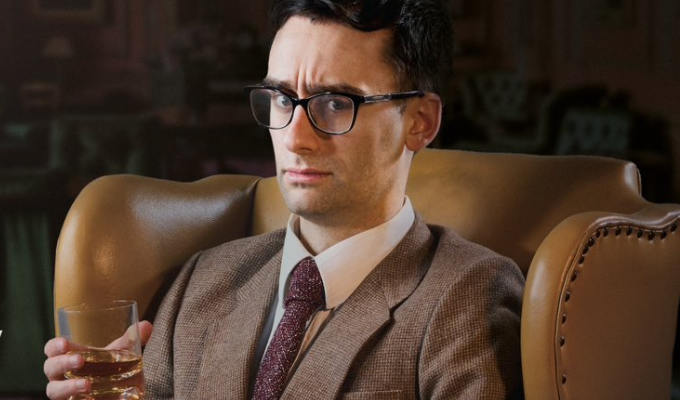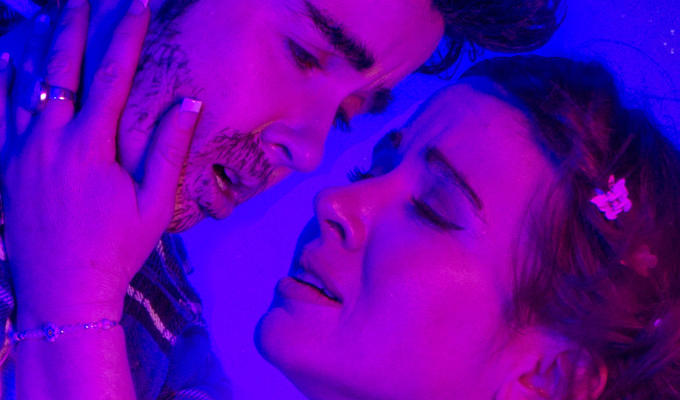Hancock at ATV
Peter Gordon reappraises a forgotten series
Unloved and virtually unseen since its original broadcast in 1963, the ATV Hancock series, made following his move from the BBC, is in fact very revealing. The BBC TV shows, particularly the last three series, are rightly lauded as some of the finest pieces of British television ever made. A comedy actor at the top of his game, a pair of writers working in total harmony with their characters, a strong supporting cast and a fine director: all work together in perfect union.By comparison, the ATV series is patchy. A handful are wonderful, but even at its worst the series is fascinating viewing because they illustrate what it is that makes the BBC TV Hancock shows so great. Hancock’s performances in Galton and Simpson’s scripts are so effortless, with a thousand and one deft touches in each show. When one or more of the elements the BBC show relied on are taken away we can begin to appreciate what a great work of art the former shows were.
The first difference we notice with the ATV shows in the opening sequence. The BBC TV shows had opened with Wally Scott’s famous Hancock Theme, a jaunty piece for tuba with light orchestra, inherited from the old radio series. The TV version accompanied the theme with some sliding animations before the lad himself appeared to breathily announce the title of the show. Like all the best TV opening sequences, it is instantly recognisable, quite distinct from anything before or since. It is also worth noting that all the programme’s incidental music is based on the Hancock Theme, before the closing music which, again, is the same tune but given the full orchestral treatment. It gives the show a unified feel: you only have to hear that "la-da-da-daa de-daa" and you know you are in Hancock’s world. The tune almost seemed to embody the man.
The ATV music, by contrast, is a rather forgettable piece for harpsichord and flute; jolly enough but nothing special. The accompanying film simply shows Hancock, in homburg and sheepskin coat, standing on a traffic island smoking a fag. It’s a tremendous let down. Where the BBC theme welcomed you into the shows’ own universe and whetted the appetite for what was to come, the ATV one merely announces that the show has begun*.
The shows themselves recreate the whittled down version of Hancock taken from the last BBC series. Over the course of his career, Hancock had famously stripped his creation of all the, as he saw it, unnecessary conventional comedic trappings. There were no catchphrases. Sidekicks like Bill Kerr, Hattie Jacques and Kenneth Williams’ Snide had all gone. By the final BBC TV series he had cast off Sid James for fear of being trapped in a double act, and had re-located the show from Railway Cuttings in fictional East Cheam to a bedsit in factual Earls Court.
It was a huge gamble, but the move towards greater naturalism paid off. Where earlier shows had sometimes relied on rather heavy handed plots devices, often based upon Hancock’s getting embroiled in some scheme dreamed up by Sid James, the new shows came out of very ordinary situations - getting in a lift, giving blood, amateur radio buffs, or just sitting in a flat getting bored.
But where the BBC show seemed effortlessly to find situations for a lone Hancock to get himself in to, the ATV one often struggled.
One of the worst examples is The Craftsman. It opens well enough, with Hancock walking down the street admiring the handiwork of an old lamplighter, who claims to be one of the last still working. Further on he joins a crowd standing outside a shop window full of televisions. The TVs are showing a DIY programme and Hancock, lost in reverie about the dying crafts, begins boasting to the other onlookers about his own skills with a saw and screwdriver.
One of the onlookers is Stan Lovegrove (Brian Wilde), a hen-pecked husband who, by coincidence, has been told by his wife that he must put up a new wardrobe and so enlists Hancock to come round and do it for him. As plot devices go, it’s incredibly clunky, a million miles away from Galton and Simpson’s smoothly naturalistic situations.
The rest of The Craftsman is little better. There’s a scene in a builders’ shop where Hancock tries to show off his nonexistent knowledge of carpentry to an unimpressed salesman which works well enough, but once he starts building Lovegrove’s wardrobe itself the show soon descends into broad slapstick. It looks far more like a sketch from pantomime than anything one would associate with Hancock.
Other shows have far better situations, but still manage to get something strangely wrong. The Man On The Corner, for instance, has all the makings of a marvellous Hancock, but something in the show’s payoff seems terribly awry.
It begins with Hancock standing in the street passing the time of day with the series’ only other semi-regular character, a newspaper seller played by Wilfrid Lawson. (Perhaps not a good idea to put Hancock, who was already having problems controlling his drinking, together with Lawson, one of the acting world’s most renowned alcoholics.) Hancock then spots a man in a pulled down hat and dark glasses dropping a suspicious parcel. He automatically assumes the man must be a spy and tries to alert the police. And when the officer gives him the brush off, he goes to the Secret Service. They gently humour him and eventually fob him off by telling him he’s been recruited as a secret agent and to follow and arrest the man in the hat himself.
After a comical chase sequence around a chemists’, Hancock tracks the man down to his flat. Somewhat unexpectedly, the man does indeed turn out to be a spy. While Hancock is interrogating him, the spy receives a phone call from his controller who wants to arrange a meeting, so Hancock gets to arrest the both of them. At the end of the show, Hancock meets up again with the policeman who originally gave him the brush off and rubs his nose in it before walking off with a big smile on his face.
This is, in many ways, a great little show. There are some excellent sequences in it, such as the wonderful lanky and chinless James Villiers as a secret service agent being asked to dress up as Hancock’s spy. Another scene worth relishing occurs when Hancock arranges the meeting with the spy controller. They agree to meet by a telephone box, with the password, "Can you direct me to the traffic lights?" Of course, there’s a queue of people outside the phone box, all of whom very helpfully try to direct him, much to his frustration. But the ending feels all wrong. Hancock as winner, the one who was right all along?
The project must have seemed, at least initially, a promising one. Despite the lack of Galton and Simpson, the series’ main writer was Godfrey Harrison, who had found success first on radio then television with A Life Of Bliss, based around George Cole as David Bliss, a Walter Mitty-ish bachelor not a million miles from Hancock’s character. Harrison was an experienced comedy writer and had even written the scripts for Hancock’s first ever regular television appearance, a segment of Kaleidoscope for BBCTV called Fools Rush In, which ran for five slots in 1951.
Harrison had some trouble delivering scripts on time, so to take some of the pressure of him ATV brought in Terry Nation, Dennis Spooner and Richard Harris. Nation, of course, went on to gain fame as creator of the Daleks, but at this point was a jobbing gag writer who had worked on Hancock’s stage show.
Spooner and Harris were a young writing partnership, both of whom went on to write for hit action adventure series such as Man In A Suitcase and The Avengers. Alan Tarrant, the director, had had a number of hits, including The Larkins (a mainly forgotten show now but a huge success in its time, starring Peggy Mount). A strong supporting cast was assembled, and Hancock appointed himself producer, presumably to ensure that his own standards of quality were maintained.
In his excellent book Tony Hancock – Artiste, Roger Wilmut tells the story of the series’ disintegration. Tarrant originally planned one month’s preparation time, but it ended up being only ten days. Harrison’s scripts were late and could over-run by twenty to thirty minutes, while the majority of shows written by Nation, Spooner and Harris were below par.
Hancock found the pressures and responsibilities of being producer overbearing and this, along with his off-screen drinking, began to affect his on-screen performance and appearance. Matters were not helped by Hancock’s insistence that the show be recorded without an studio audience, then edited and presented to an audience for the laughter track.
The same method was employed on the first series of The Blackadder, with the same results. Actors used to performing in front of live audiences lost their timing. People talked over audience laughter. The whole feel of the show becomes disjointed. As the series progressed, Hancock began to rely almost entirely on teleprompters rather than memorising his lines, and by the end of the thirteen shows the series’ momentum had fizzled away.
But buried within the ATV series are three shows which do stand up to comparison with the BBC programmes: The Assistant, Shooting Star and The Girl. Wilmut’s book talks at great length about The Assistant and The Girl (notably, the former contains the last ever screen performance by the great Mario Fabrizi who sadly died in April 1963 at the age of 38).
Shooting Star, too, deserves to be remembered as a great show. Hancock starts the show, once again, standing on a street corner. He is spotted by Peter Dartford (Denholm Elliot), a film director from the Kitchen Sink school of realism who prefers using ordinary people in his films rather than trained actors. He hires Hancock to star in his new film, which, instead of being shot on a studio set, is being filmed in a real house. The only trouble is no one’s told the old lady who lives in the house, who keeps coming in and interfering with the action. It’s a wonderful set up, perfectly made for Hancock as the old lady constantly undermines his newly found thespian pretensions.
These three shows together demonstrate what the ATV series could have been, and would make a wonderful video/ DVD release. At the time of writing we are lead to believe Hancock’s estate is set against any form of release for the ATV series. This is a huge shame, as these three shows alone would be a great treat for any fan of the lad himself.
This article originally appeared in i ssue two of Kettering: the magazine of elderly British comedy. Kettering 2 also features articles on Spike Milligan's Q, Marty Feldman, Irene Handl, Ray Cooney, The Lovers and more. It is available for £3 (UK) or £5 (overseas). For details, contact clinty@stabbers.org
First published: August 1, 2004
Published: 22 Mar 2009






